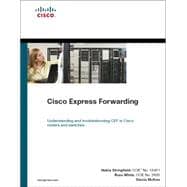Cisco Express Forwarding
Understanding and troubleshooting CEF in Cisco routers and switches
Nakia Stringfield, CCIE® No. 13451
Russ White, CCIE No. 2635
Stacia McKee
How does a router switch a packet? What is the difference between routing a packet, switching a frame, and packet switching? What is the Cisco® Express Forwarding (CEF) feature referred to in Cisco documentation and commonly found in Cisco IOS® commands? CEF is a general term that describes the mechanism by which Cisco routers and Catalyst® switches packet-switch (route) frames. CEF is found in almost all Cisco routers and Catalyst switches, and understanding how CEF operates can improve the performance, scalability, and efficiency of your network.
Cisco Express Forwarding demystifies the internal workings of Cisco routers and switches, making it easier for you to optimize performance and troubleshoot issues that arise in Cisco network environments. This book addresses common misconceptions about CEF and packet switching across various platforms, helping you to improve your troubleshooting skills for CEF- and non-CEF-related problems.
The first part of the book provides an overview of packet-switching architectures and CEF operation and advanced features. It also covers the enhanced CEF structure and general troubleshooting. The second part of the book provides case studies that focus on the common topics that have been problematic for customers and those supporting Cisco networks.
Full of practical examples and configurations, this book draws on years of experience to help you keep your Cisco networks running efficiently.
Nakia Stringfield, CCIE® No. 13451, is a network consulting engineer for Advanced Services at Cisco, supporting top financial customers with network design and applying best practices. She was formerly a senior customer support engineer for the Routing Protocols Technical Assistance Center (TAC) team troubleshooting issues related to CEF and routing protocols. Nakia has been with Cisco for more than six years, previously serving as a technical leader for the Architecture TAC team.
Russ White, CCIE No. 2635, is a Principle Engineer in the Routing Protocol Design and Architecture team at Cisco. He is a member of the IETF Routing Area Directorate, co-chair of the Routing Protocols Security Working Group in the IETF, a regular speaker at Cisco Networkers, a member of the CCIE Content Advisory Group, and the coauthor of six other books about routing and routing protocols, including Optimal Routing Design from Cisco Press. Russ primarily works in the development of new features and design architectures for routing protocols.
Stacia McKee is a customer support engineer and technical leader of the Routing Protocols Technical Assistance Center (TAC) team. This team focuses on providing post-sales support of IP routing protocols, MPLS, QoS, IP multicast, and many other Layer 3 technologies. Stacia has been with Cisco for more than six years, previously serving as a technical leader of the Architecture TAC team and a member of the WAN/Access TAC team.
- Learn the key features of packet-switching architectures
- Understand the basics of the CEF architecture and operation
- Examine the enhanced CEF structure, which improves scalability
- Learn how to troubleshoot in software-switching environments
- Understand the effect of CEF on a Cisco Catalyst 6500 Supervisor 720
- Configure and troubleshoot load sharing with CEF
- Evaluate the effect of CEF in an MPLS VPN environment
- Review CEF design considerations that impact scalability
Part I Understanding, Configuring, and Troubleshooting CEF
Chapter 1 Introduction to Packet-Switching Architectures
Chapter 3 CEF Enhanced Scalability
Chapter 4 Basic IP Connectivity and CEF Troubleshooting
Part II CEF Case Studies
Chapter 5 Understanding Packet Switching on the Cisco Catalyst 6500 Supervisor 720
Chapter 6 Load Sharing with CEF
Chapter 7 Understanding CEF in an MPLS VPN Environment
Part III Appendix
Appendix A Scalability
This book is part of the Networking Technology Series from Cisco Press®, which offers networking professionals valuable information for constructing efficient networks, understanding new technologies, and building successful careers.
Category: Networking
Covers: Routing and Switching
1587052369








